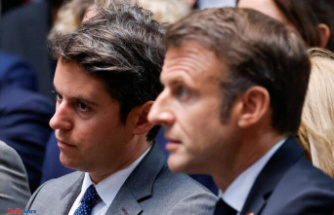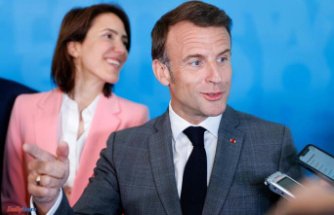The three gas leaks at Nord Stream 1 and 2 are causing debate. The cause is still unclear. But there are many indications of a targeted attack. Swedish measuring stations register two explosions the night before. Ukraine suspects those responsible in the Kremlin - from there it is said that they are "concerned".
In the case of the leaks in the Baltic Sea pipelines Nord Stream 1 and 2 from Russia to Germany, sabotage is in the room. "A coincidence is hard to imagine," said Denmark's Prime Minister Mette Frederiksen. Expert opinions and assessments from security circles also point in this direction. The Kremlin also stated that it could not rule out an act of sabotage. Meanwhile, Kyiv claims to have already identified the culprit. What is known about the gas leaks so far:
The Danish and Swedish authorities confirmed on Tuesday morning that gas was leaking from the Nord Stream 1 pipeline at two points. The leaks occurred near the Danish island of Bornholm in Danish and Swedish territorial waters. A leak was also reported in the Nord Stream 2 pipeline. The Danish Navy released images showing large-scale formation of bubbles on the sea surface. At one point, the bubbles can be observed on a circular area a good kilometer in diameter, the military said.
As none of the natural gas pipelines are currently operational, the incidents have no impact on Europe's energy supply at this time. The current gas supply in Germany is therefore not affected. "We do not see any effects on the security of supply," said the Federal Network Agency. "No gas has flowed through Nord Stream 1 since Russia stopped deliveries at the beginning of September. The storage levels are still rising steadily. They are currently around 91 percent."
On the night of Monday, a sharp drop in pressure was initially detected in one of the two tubes of the unused Nord Stream 2 pipeline. On Monday evening, the operator then also reported a drop in pressure in both tubes of Nord Stream 1. The Federal Ministry of Economics and Technology (BMWK) and the Federal Network Agency unanimously announced that they were in contact with each other and with the authorities concerned in order to clarify the matter. According to a spokesman for Nord Stream 2, natural gas will continue to flow into the Baltic Sea for days.
There is no official information on a possible cause of the damage. However, according to a media report, measuring stations in Sweden and Denmark recorded powerful underwater detonations before the Nord Stream gas leaks in the Baltic Sea. There is no doubt that there were blasts or explosions, seismologist Björn Lund from the Swedish Seismological Network (SNSN) told Swedish radio station SVT. There were two clear detonations in the area on Monday, the broadcaster reports, citing the network - one at 2:03 a.m. and a second at 7:04 p.m. in the evening. According to "Spiegel" information, the lines were torn open over long distances. The "explosive drop in pressure" in the pipelines cannot be explained otherwise, according to government officials.
Such gas leaks are "extremely rare," said a spokesman for the Danish authorities. "Due to the incidents of the past 24 hours, we see reason to increase the level of security" to monitor the energy infrastructure. "It is an unusual situation that three leaks occur not far from each other," said Prime Minister Frederiksen. Sabotage is therefore not excluded. The Prime Minister was in Budno, Poland, where a new pipeline from Norway via Denmark and through the Baltic Sea to Poland was inaugurated.
Mykhailo Podoliak, advisor to Ukrainian President Volodymyr Zelensky, also assumes that the gas leaks on the Nord Stream 1 Baltic Sea pipeline were caused intentionally - and immediately names a culprit: It is "nothing more than a terrorist attack planned by Russia and an act of aggression against the EU," he tweeted. Russia wants to destabilize the economic situation in Europe and spread panic before winter. "The best answer and security investment - tanks for Ukraine," Podoliak said. "Especially German…"
Meanwhile, the government in Moscow was also "extremely concerned" about the reported leaks. "This is an unprecedented situation that needs urgent investigation," said Kremlin spokesman Dmitry Peskov. When asked if it could be an act of sabotage, he said "no" option could be ruled out.
Sabotage is also assumed in German security circles, reports the Berlin "Tagesspiegel", citing insider information. "Our imagination no longer gives us a scenario that is not a targeted attack," said a person who was informed about the assessment by the federal government and the federal authorities. It also said: "Everything speaks against a coincidence." Such a suspected attack on the seabed is anything but trivial, it has to be carried out with special forces, for example navy divers, or a submarine, according to the newspaper from circles informed about the first assessment of the situation.
Referring to sources close to the federal government, the "Spiegel" reported that there were fears that the attack was intended to provoke uncertainty on the European gas markets. The safety concepts of other pipelines and gas supply systems are currently being reviewed.
An EU Commission spokesman said in Brussels: "An act of sabotage against the infrastructure would of course be something we would condemn." However, it is still too early to assess the reasons for the leaks. The Commission is in contact with the Member States concerned.
With regard to the authorship of the alleged attacks, according to the "Tagesspiegel", two possibilities are being discussed in security circles. On the one hand, according to the speculation, Ukrainian forces or forces linked to Ukraine could be responsible. With the Nord Stream pipelines temporarily switched off, gas deliveries from Russia to Germany and Central Europe would only be possible via the Yamal connection via Poland or the Ukrainian pipeline network.
On the other hand, it is exactly the same scenario, but as a so-called "false flag" operation by Russia, a possible explanation for the leaks in the pipelines. This could fuel additional uncertainty and gas prices could possibly be driven up again in order to exacerbate the European energy price crisis, which had recently eased minimally.
German naval inspector Jan Christian Kaack recently warned of Russian attacks under water. "Russia has also built up significant capacities under water," said the Vice Admiral. "On the bottom of the Baltic Sea, but also in the Atlantic, there is some critical infrastructure such as pipelines or undersea cables for IT. They can quickly switch off the lights in countries like Estonia, and there are threats to global communication structures that you have to pay particular attention to. " According to Kaack, Russian underwater or surface units have recently been in the area of these cables for a long time.
The extent of the damage to the pipeline is not yet clear, a Nord Stream 2 company spokesman said. According to energy expert Nicolas Goldberg of consulting firm Colombus, an underwater gas leak is not easily repairable, especially if salt water got into the pipe. Both lines are filled with gas, although they are not in operation.
The Bund für Umwelt und Naturschutz (BUND) estimates the short-term effects of the leaks on the environment as locally limited. "However, there is a risk for the animals to suffocate. This particularly affects the animals that cannot escape quickly," said Nadja Ziebarth, head of the BUND marine protection office, of the "Tagesschau".
Pure methane that dissolves in the sea is non-toxic. However, the exact composition of the escaping gas, which usually also consists of other hydrocarbons, is not known. "Since it is unclear exactly which mixture is being transported in Nord Stream, other gases could cause unknown damage to the marine ecosystem locally," warned Ziebarth.












